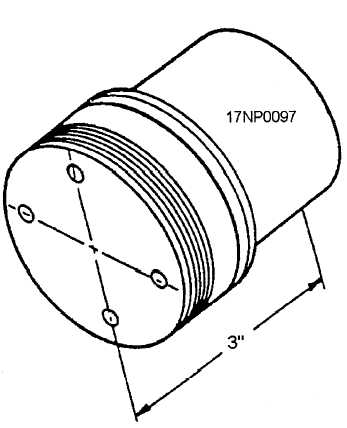IMPACT FIRING FUZES.— Impact firing fuzes
(fig. 2-19) function when the rocket strikes a target that
offers sufficient resistance to cause crushing or other
disarrangement of actuating parts.
All current impact firing rocket fuzes have the same
type of safety/arming mechanism. This mechanism
consists of an unbalanced rotor, which, under setback
forces, drives a gear-train timing system. A given
minimum acceleration over a given length of time is
required to complete the arming cycle. If rocket
acceleration is too low or extends over too short a
period of time, the arming mechanism returns to the
unarmed condition. The timing mechanism provides a
safe separation distance from the launcher before
arming.
When located in the nose of the warhead, impact
firing fuzes are known as point-detonating (PD) fuzes.
If they are located in the base of the warhead, they are
known as base-detonating (BD) fuzes. Nose and base
Figure 2-20.—Mk 193 Mod 0 mechanical time fuze.
fuzes function either instantaneously or after a short
delay that gives the warhead time to penetrate the target
before functioning.
MECHANICAL TIME FUZES.— Mechanical
time fuzes (fig. 2-20) function by the action of a
mechanical timer. These fuzes contain a safety/
arming device and a clock mechanism. The arming
mechanism is similar to those in impact detonating
fuzes and requires a minimum acceleration over a
given time to complete the arming cycle. Upon
arming, the mechanical timer is started, and after a
set elapsed time, the fuze initiates the firing
train.
The Mk 193 Mod 0 is the only mechanical time
rocket fuze currently in use. It is permanently installed
in the nose of the Mk 33 Mod 1 flare warhead.
ACCELERATION-DECELERATION FUZES.—
Acceleration-deceleration fuzes are similar to impact
and time fuzes because they require acceleration for a
given time to complete the arming cycle. After the
arming cycle is completed and the rocket velocity begins
to drop, deceleration causes the fuze to function.
The Model 113A is the only acceleration-
deceleration fuze in use by the Navy at this time. It is a
base-mounted fuze that is permanently installed in the
WDU-4A/A flechette warhead.
PROXIMITY FUZES.— Proximity fuzes,
sometimes referred to as VT fuzes (figs. 2-21 and 2-22),
initiate by “sensing,” usually by electronic means, the
presence and distance of a target. Proximity fuzes are
primarily used in air-to-ground operations where air
bursts above the target are desired. They are not
suitable for use against targets that require penetration
and detonation within the target for effective
destruction.
In general, proximity fuzes consist of an electronics
package in the forward end, a thermal battery, a
safety/arming device, and an explosive booster in the
base. The arming mechanism is similar to those in
impact detonating fuzes, and it requires a minimum
acceleration over a given time to complete the arming
cycle.
2-15


